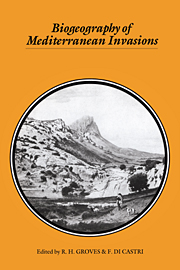Book contents
- Frontmatter
- Contents
- List of contributors
- Preface
- Part I Introduction
- Part II Historical background
- Part III Biogeography of taxa
- 7 Invasive plants of the Mediterranean Basin
- 8 Invasive vascular plants of California
- 9 Introduction of plants into the mediterranean-type climate area of Chile
- 10 Introduced plants of the fynbos biome of South Africa
- 11 Invasive plants of southern Australia
- 12 Life cycles of some Mediterranean invasive plants
- 13 Invasion processes as related to succession and disturbance
- 14 Is fire an agent favouring plant invasions?
- 15 Plant invasion and soil seed banks: control by water and nutrients
- 16 Invasion by annual brome grasses: a case study challenging the homoclime approach to invasions
- 17 Patterns of Pleistocene turnover, current distribution and speciation among Mediterranean mammals
- 18 Introduced mammals in California
- 19 Ecology of a successful invader: the European rabbit in central Chile
- 20 Mammals introduced to the mediterranean region of South Africa
- 21 Mammals introduced to southern Australia
- 22 Invasions and range modifications of birds in the Mediterranean Basin
- 23 Invasions in the mediterranean avifaunas of California and Chile
- 24 Birds introduced to the fynbos biome of South Africa
- 25 Species of introduced birds in mediterranean Australia
- Part IV Applied aspects of mediterranean invasions
- Part V Overview
- Index of scientific names
- Subject index
20 - Mammals introduced to the mediterranean region of South Africa
Published online by Cambridge University Press: 02 December 2009
- Frontmatter
- Contents
- List of contributors
- Preface
- Part I Introduction
- Part II Historical background
- Part III Biogeography of taxa
- 7 Invasive plants of the Mediterranean Basin
- 8 Invasive vascular plants of California
- 9 Introduction of plants into the mediterranean-type climate area of Chile
- 10 Introduced plants of the fynbos biome of South Africa
- 11 Invasive plants of southern Australia
- 12 Life cycles of some Mediterranean invasive plants
- 13 Invasion processes as related to succession and disturbance
- 14 Is fire an agent favouring plant invasions?
- 15 Plant invasion and soil seed banks: control by water and nutrients
- 16 Invasion by annual brome grasses: a case study challenging the homoclime approach to invasions
- 17 Patterns of Pleistocene turnover, current distribution and speciation among Mediterranean mammals
- 18 Introduced mammals in California
- 19 Ecology of a successful invader: the European rabbit in central Chile
- 20 Mammals introduced to the mediterranean region of South Africa
- 21 Mammals introduced to southern Australia
- 22 Invasions and range modifications of birds in the Mediterranean Basin
- 23 Invasions in the mediterranean avifaunas of California and Chile
- 24 Birds introduced to the fynbos biome of South Africa
- 25 Species of introduced birds in mediterranean Australia
- Part IV Applied aspects of mediterranean invasions
- Part V Overview
- Index of scientific names
- Subject index
Summary
In contrast to the marked impact exerted by introduced plants (Wells, this volume), introduced mammals are unimportant in the South African mediterranean zone. This relative unimportance is partly because of historical accident but also because the characteristics of fynbos, the dominant vegetation type in the region, have influenced the establishment of introduced mammals.
Commensal rodents
Commensal rodents were the first comers. The house or black rat, Rattus rattus, is known from Iron Age sites in Zambia (ad 1500–1600), the northern Transvaal (about ad 1000) and Natal (8th century) (Avery, 1985). Whether they travelled southward to reach the mediterranean-climate region or whether there was a fresh introduction at the Cape from European ships – which seems likely – is not known. The species is well established as a commensal in all but the drier parts of South Africa, as well as in many other parts of Africa (de Graaf, 1981). Feral populations were reported in forests at Pirie and in Pondoland, eastern Cape Province, by Shortridge (1934). Smithers (1983) stated that where, in restricted local areas, they have established themselves in the field, black rats have done so where there is thick underbrush in forested areas or other types of substantial cover. There are no such records from the mediterranean zone of South Africa. There is no evidence of black rats affecting vegetation or the populations of indigenous birds or mammals, as they have done, for example, in New Zealand, the Galapagos and Hawaii (Lever, 1985). The relative importance of physiological and ecological requirements, competition and predation (many wild predators take the species; see Kingdon, 1974; de Graaf, 1981) in restricting black rats to commensalism is not known.
- Type
- Chapter
- Information
- Biogeography of Mediterranean Invasions , pp. 285 - 292Publisher: Cambridge University PressPrint publication year: 1991

